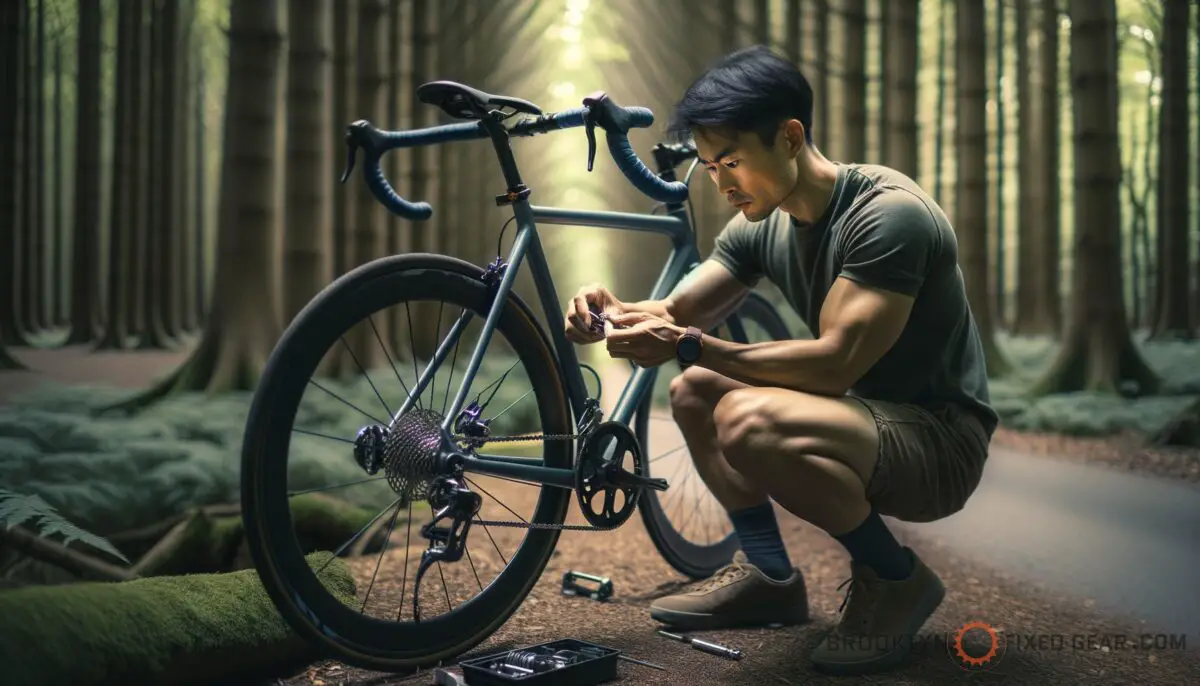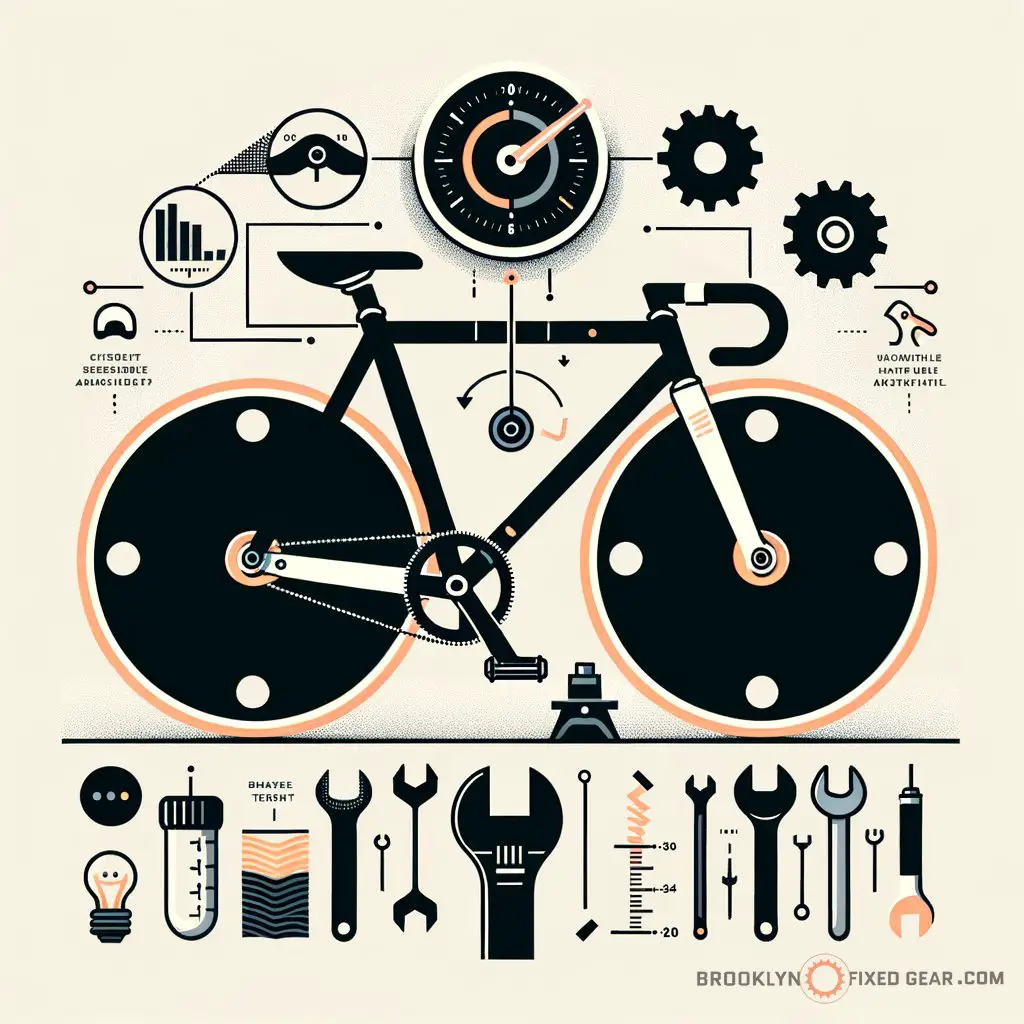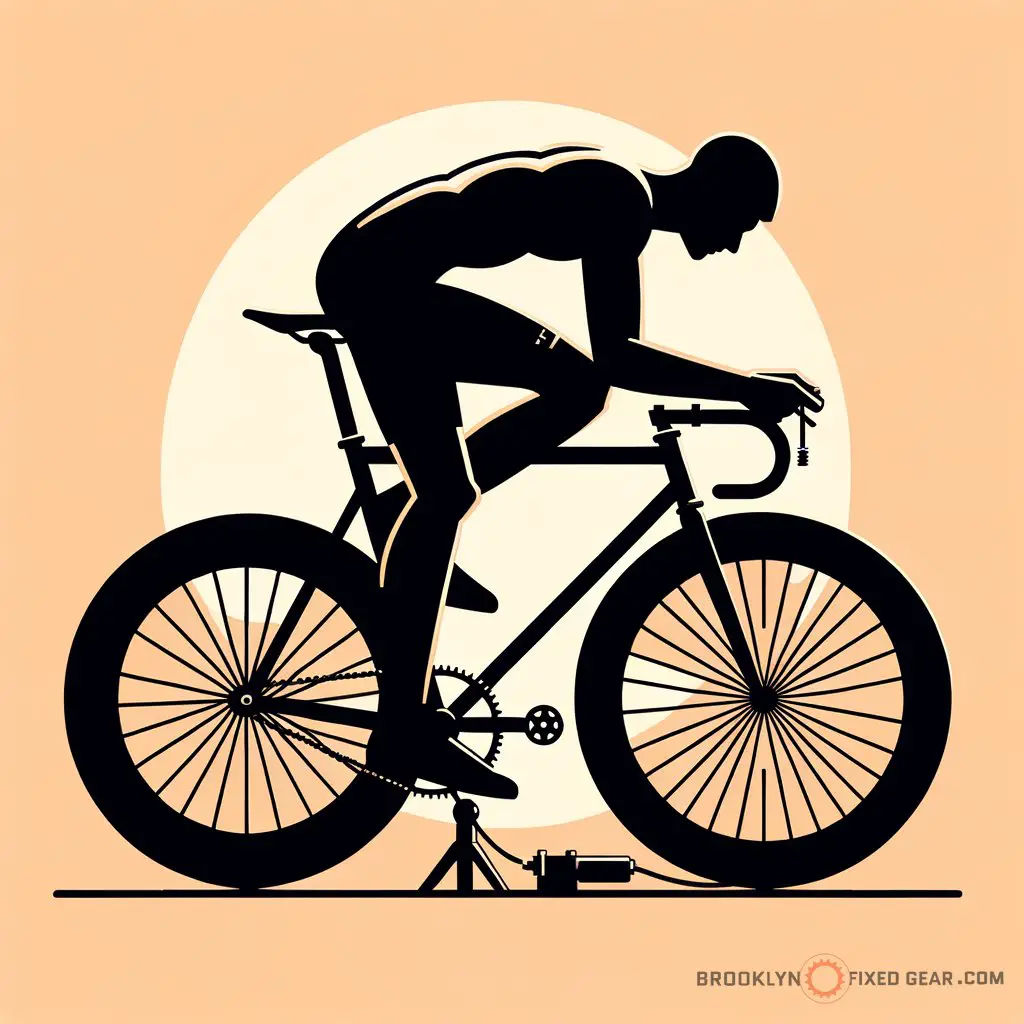Ever wondered about perfecting your ride with a track bike or fixie? Curious about what it takes to dial in your cycling performance? You’re not alone! What does ‘dialing in’ really mean for cyclists like us? Let’s get into the nitty gritty, and if you’re still hunting for that perfect ride, check out some of the best fixie bikes available.
We’ll cover the essentials of tuning your bike for peak performance.
Key takeaways
- Dialing in fine-tunes your bike for comfort, efficiency, and performance.
- Maintain your bike regularly and adjust components to prevent wear.
- Invest in quality tools for precise maintenance on the go.
What is dialing in context of cycling
Dialing in your bike is an art form, a means to fine-tune your trusty steed to resonate with your riding style and preferences. It’s about getting every component working in harmony, so your rides are smooth, efficient, and responsive. Here’s a breakdown of what it entails:

- Achieving the perfect fit: This is where you tailor the bike’s saddle, handlebars, and pedal positions to ensure you’re riding both comfortably and efficiently.
- Adjusting for performance: It’s about tweaking the gear ratios, brake tension, and tire pressure for a responsive and agile ride on the streets of New York or wherever your fixie takes you.
Dialing in also involves the incremental adjustments you make as you and your bike grow together. It’s the ongoing relationship between rider and machine, with periodic tune-ups and alterations that cater to evolving skills or varying terrains. And with the right multi-tool, it’s something you can manage by yourself, right there on the side of the road or before you set out for the day.
Ultimately, it’s the pursuit of that ‘just right’ feeling. It’s pushing a button on a vintage amp until the sound is crisp, clear, and free of distortion. It’s not just maintenance, it’s personalization; your bike becomes an extension of yourself.
As someone who’s more at home skimming the asphalt with a fixed cog than braving rocky terrains, I reckon dialing in is crucial. It puts you in sync with your ride, and let’s face it, on the track or city streets, that can make all the difference. I remember hearing about an old-school messenger who could tell if his saddle was just a millimeter off just by the way his bike handled on a familiar turn.
It’s kinda like that scene in ‘The Italian Job’ where the getaway drivers fine-tune their Mini Coopers for the big heist — they know the importance of every little adjustment.
That story stuck with me because it shows how a well-dialed bike can almost feel like a part of you. And while I may not be leading a thrilling chase through the subway tunnels like in the movies, getting my fixie dialed in is my kind of thrill. Plus, it’s a little bit of city wisdom that’s handy for survival on these fast-paced streets.
And if you’re putting together a new project, avoid the hiccups with these tips on building a fixie.
State Bicycle Co. Black Label 6061

State Bicycle Co. Black Label 6061
Understanding dialing in cycling
Dialing in refers to fine-tuning your bike to your specific needs, and getting this right is key to a comfortable and efficient ride. It’s a series of adjustments and checks made to personalize the bike fit, performance, and comfort for the rider.
Dialing in your fit
Getting the bike fit dialed in is the starting point for any cyclist. This includes setting the saddle height for optimal leg extension, adjusting the saddle fore/aft position, and tuning handlebar reach and height for comfort and efficiency.

- Crucial for comfort and performance: A proper fit helps prevent injuries and ensures maximum power transfer.
- Involves measurements and adjustments: Use a plumb line for saddle positioning and a level for handlebar alignment. For these tasks, a good bike multi-tool can be your best ally.

Dialing in for optimal performance
Performance adjustments are about making sure all components work smoothly. This includes calibrating gear shifts for precision, adjusting brake tension for effective stopping power, and ensuring the wheels are true for a smooth ride.
- Improves handling: Fine-tuned brakes and gears respond better under different cycling conditions.
- Increases bike lifespan: Regular adjustments can ward off wear and tear, as explained in the guide on how to replace a bike chain.
Personalization through dialing in
Beyond fit and performance, dialing in allows you to customize your bike to reflect your personality and style. This might include choosing specific handlebars or selecting a unique bike saddle.
- Reflects the rider’s style: Custom handlebars and saddles set your bike apart from the rest.
- Enhances the riding experience: Personal touches can make your bike feel truly yours, and a delight to ride every day.
While preparing this table, consider what matters to you most when dialing in your bike. Is it the comfort, the performance, the style, or a blend of all three? Maybe you’ve noticed the trend that the average age of cyclists is rising, as highlighted in insurance data, which could influence how bikes are dialed in for an older demographic.
Please note the below data table is for illustration purposes based on the given input and may not reflect real data.
Summary of table: This data table presents key aspects to consider when dialing in your bike, such as fit, performance, and personalization, alongside the tools and components you might need.
| Important Elements of Dialing In | Description | Tools/Components Needed |
|---|---|---|
| Bike Fit | Tailoring saddle height, position, and handlebar alignment for an optimal riding position. | Level, plumb line, bike multi-tool |
| Performance Tuning | Adjusting gear shifts, brake tension, and wheel truing. | Chain whip, hex keys, truing stand |
| Personal Touches | Adding custom components like handlebars and saddles for individual style. | Custom handlebars, unique saddles |
Investing in quality tools for maintenance and adjustments not only makes the process easier and more precise, it ensures your ride is always in tune with your needs. Remember, changes in weather can affect bike performance—adjust accordingly to keep your ride smooth and efficient.
A table displaying the crucial elements of dialing in a bike, the descriptions of these elements, and the tools or components required for each step.
More dialing in cycling tips
If you’re looking to get even more dialed in with your fixed-gear or track bike, there are several other finer points you can address. Here are some tips to ensure every element of your ride is tuned to your liking.
- Keep a log of changes you make to your bike’s setup so you can trace back steps if needed.
- Invest in quality tools for maintenance and adjustments to make the process easier and more precise.
- Always test ride your bike after making adjustments to ensure everything feels right.
- Remember that changes in weather can affect tire pressure and bike performance, so adjust accordingly.
- Don’t forget the importance of a sleek and functional design that doesn’t compromise the bike’s aesthetics.
Now let’s look at the dos and don’ts when dialing in your bike, which can save time and enhance the overall experience.
| Do | Don’t |
|---|---|
| Do test different settings to find what works best for you. | Don’t rush the adjustment process; take your time. |
| Do use quality components that match your riding style. | Don’t ignore small issues; they can lead to bigger problems. |
| Do maintain your bike regularly to keep it dialed in. | Don’t make changes based on trends; focus on what suits you. |
A practical guide to the dos and don’ts of dialing in your cycling experience for optimal performance and comfort.
Advantages and disadvantages of dialing in cycling
Dialing in your bike can transform your cycling experience, but it’s important to weigh both the advantages and the disadvantages.
Advantages
- Enhanced bike performance leading to a smoother, faster ride.
- Increased comfort during long rides, potentially reducing fatigue.
- Improved bike handling, which can lead to better safety and control.
- Personalization of the bike to fit your body and riding preferences.
Disadvantages
- Time-consuming process that requires patience and attention to detail.
- Potential costs associated with purchasing special tools or components.
- The need for frequent adjustments as components wear or your riding style changes.
- Possibly over-tuning, leading to discomfort or mechanical issues.
If you are a visual learner, check out this video titled ‘Cycling Cadence Explained’
Frequently asked questions (FAQ)
Is it necessary to dial in a new bike or one straight off the shelf?
Even new bikes can benefit from dialing in, as manufacturers set them up to generic standards that may not suit your specific body dimensions or riding style. Custom adjustments can enhance your comfort and performance right from the start.
How usually should I check and adjust my bike’s dialing?
You should check your bike’s settings regularly, especially if you ride frequently or if the bike is new, as components can settle and shift with use. A good rule of thumb is to give your bike a quick once-over before every ride, with more thorough checks every few months or as needed.
Can the process of dialing in affect the warranty of my bike?
Adjustments made within the scope of normal maintenance typically do not affect a bike’s warranty. However, significant modifications or unauthorized repairs could potentially void the warranty, so it’s important to consult your warranty details before proceeding.
Final thoughts
Dialing in might seem like just another chore in the vast world of cycling, but in reality, it defines the relationship between you and your ride. It can transform a good bike into a great one and elevate your cycling experience to new heights. As you tweak and adjust, you learn more about the intricacies of your bike and how it responds to the city’s rhythm.
Whether you’re looking to shave seconds off your track time or simply enjoy a more comfortable commute, remember that the perfect ride is always within reach—one adjustment at a time.
What’s your experience with dialing in your bike? Did I cover everything you wanted to know? Let me know in the comments section below, I read and reply to every comment. If you found this article helpful, share it with a friend, and check out my full blog for more tips and tricks on cycling. Thanks for reading and keep those wheels turning!















